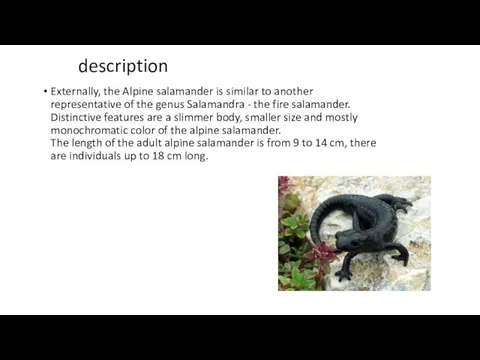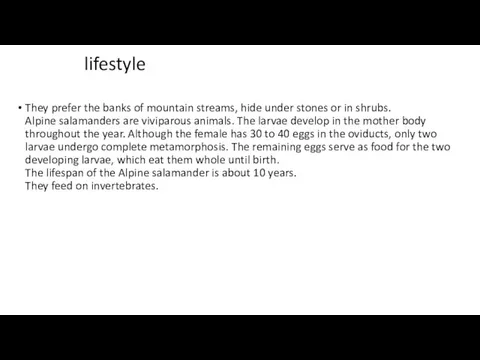Содержание
- 2. propagation The Alpine salamander lives in the central and eastern Alps at altitudes above 700 meters
- 3. description Externally, the Alpine salamander is similar to another representative of the genus Salamandra - the
- 4. lifestyle They prefer the banks of mountain streams, hide under stones or in shrubs. Alpine salamanders
- 6. Скачать презентацию
Слайд 2propagation
The Alpine salamander lives in the central and eastern Alps at altitudes
propagation
The Alpine salamander lives in the central and eastern Alps at altitudes

above 700 meters above sea level in southeastern Switzerland, western and central Austria, northern Italy and Slovenia, southern Germany and France, limited populations in Croatia and Serbia.
Kingdom: Animals
Type: Chordal
Class: Amphibians
Order: Tailed amphibians
Family: Salamanders
Genus: Salamanders
Species: Alpine salamander
Слайд 3description
Externally, the Alpine salamander is similar to another representative of the genus
description
Externally, the Alpine salamander is similar to another representative of the genus

Salamandra - the fire salamander. Distinctive features are a slimmer body, smaller size and mostly monochromatic color of the alpine salamander.
The length of the adult alpine salamander is from 9 to 14 cm, there are individuals up to 18 cm long.
Слайд 4lifestyle
They prefer the banks of mountain streams, hide under stones or in
lifestyle
They prefer the banks of mountain streams, hide under stones or in

shrubs.
Alpine salamanders are viviparous animals. The larvae develop in the mother body throughout the year. Although the female has 30 to 40 eggs in the oviducts, only two larvae undergo complete metamorphosis. The remaining eggs serve as food for the two developing larvae, which eat them whole until birth.
The lifespan of the Alpine salamander is about 10 years.
They feed on invertebrates.
 Презентация на тему ИСТОРИЯ РАЗВИТИЯ ГЕНЕТИКИ
Презентация на тему ИСТОРИЯ РАЗВИТИЯ ГЕНЕТИКИ  Мариукультура. Культивирование тихоокеанских устриц
Мариукультура. Культивирование тихоокеанских устриц Фотоальбом. Ботаника
Фотоальбом. Ботаника Великий древнегреческий учёный Теофраст
Великий древнегреческий учёный Теофраст Биология. Проверочная
Биология. Проверочная Взаимоотношения между организмами
Взаимоотношения между организмами Обмен веществ. Питание. Пищеварение
Обмен веществ. Питание. Пищеварение Экотоксикология популяций растений
Экотоксикология популяций растений Многоклеточные водоросли
Многоклеточные водоросли Органы дыхания и газообмен. 7 класс
Органы дыхания и газообмен. 7 класс физиология
физиология Cирийский хомяк
Cирийский хомяк Лексическая тема Дикие животные
Лексическая тема Дикие животные Нуклеиновые кислоты
Нуклеиновые кислоты Теоретико-методологические подходы в современной науке. Методологический подход как позиция к проблеме или явлению
Теоретико-методологические подходы в современной науке. Методологический подход как позиция к проблеме или явлению Циклоспорин А
Циклоспорин А Декоративні квіти
Декоративні квіти Зимующие птицы
Зимующие птицы Микология (греч. Микес – гриб) - наука о грибах
Микология (греч. Микес – гриб) - наука о грибах Тип кишечнополостные. Гидра
Тип кишечнополостные. Гидра Семенные растения. Голосеменные растения
Семенные растения. Голосеменные растения Ткани организма человека
Ткани организма человека Импортозамещение
Импортозамещение cf0253b2216346d4a8ffa9d47270330b
cf0253b2216346d4a8ffa9d47270330b Животные моей мечты
Животные моей мечты Нейроглия
Нейроглия Внешнее строение птиц
Внешнее строение птиц Успехи селекции микроорганизмов. Биотехнология и генная инженерия
Успехи селекции микроорганизмов. Биотехнология и генная инженерия